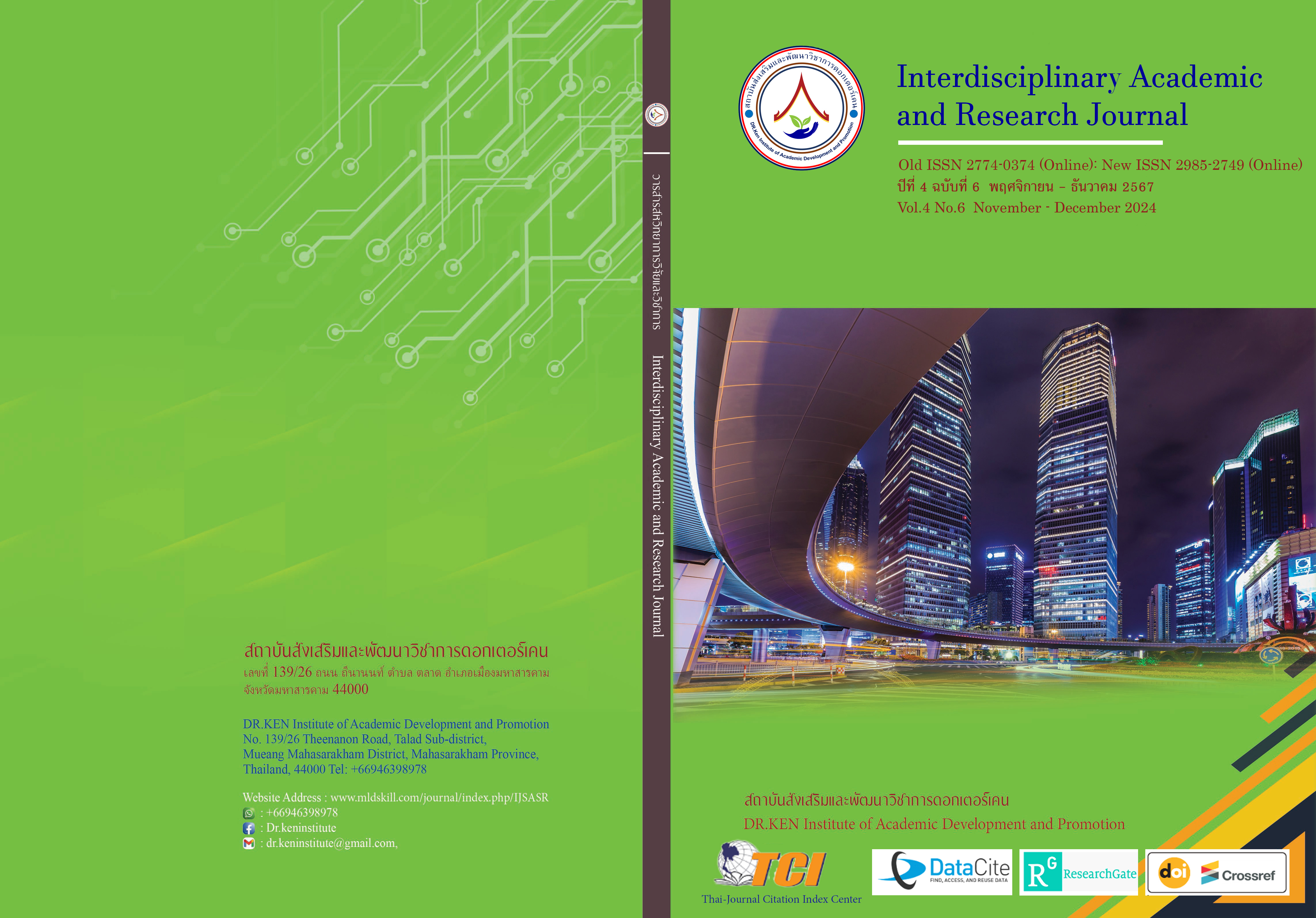The Development Guidelines for Development 21st Century Strategic Leadership of School Administrators Under the Surin Primary Educational Service Area Office 3
DOI:
https://doi.org/10.60027/iarj.2024.280001Keywords:
Guidelines for Development, 21st Century Strategic Leadership, School AdministratorsAbstract
Background and Aims: School administrators need to possess key characteristics, including strategic leadership, with the ability to look forward and set a vision that aligns with societal changes. They should also be able to develop strategic plans, and adapt new thinking and management approaches, to provide clear direction and goals for the school in line with the changes or impacts expected in the 21st century. This includes promoting education management that equips students with knowledge, learning skills, and essential skills for the 21st century world. Therefore, this research aims to study the current, desirable state and priority need index of 21st century strategic leadership of school administrators under the Surin Primary Educational Service Area Office 3 and study the guidelines for developing 21st-century strategic leadership of school administrators under the Surin Primary Educational Service Area Office 3.
Methodology: The research process was divided into 2 phases: Phase 1; to study the current, desirable state and priority need index of 21st century strategic leadership of school administrators. The sample group of 341 were school 144 administrators and 197 teachers. The research tool was a questionnaire, with a reliability of 0.95, and a discrimination power of 0.31 – 0.76. The statistics used for data analysis were mean and standard deviation. Phase 2; to study the guidelines for the development of 21st century strategic leadership of school administrators. The Key Informant groups include 7 experts for studying the development guidelines and 7 experts for evaluating guidelines. The research instruments were interview form and evaluation form the suitability and feasibility.
Results: 1. The current state overall was high average and the desirable state overall was in the highest level. The priority needs ranked from high to low level were 1) Strategic thinking 2) Communication 3) Setting direction and organizational vision 4) Revolutionary thinking. 2. The guidelines for the development of 21st century strategic leadership of school administrators were 15 guidelines as follows: 1)Strategic thinking 4 guidelines 2) Communication 4 guidelines 3) Setting direction and organizational vision 4 guidelines and 4) Revolutionary thinking 3 guidelines. The results of evaluating the suitability and feasibility of the overall approach were at the highest level.
Conclusion: Strategic leadership in the 21st century for school administrators involves demonstrating their ability to develop the school by setting directions that align with global changes in the 21st century. They must possess skills in strategic thinking, including analysis, synthesis, and the appropriate application of work based on current and future situations. Effective, clear, and direct communication is crucial, as is revolutionary thinking, which involves thinking outside the box to find innovative and creative techniques for school development and problem-solving. The components include: Setting direction and organizational vision, Strategic thinking, Communication, and Revolutionary thinking.
References
กนกอร สมปราชญ์. (2559). ภาวะผู้นำและภาวะผู้นำการเรียนรู้สำหรับผู้บริหารสถานศึกษา . ขอนแก่น: คลังนานาวิทยา.
กัณฑ์กณัฐ สุวรรณรัชภูมิ, สมชาย เทพแสง, ทัศนา แสวงศักดิ์ และอภิธีร์ ทรงบณัฑติย์. (2556). ภาวะผู้นำกลยุทธ์: รูปแบบของผู้นำยุคใหม่. วารสารบริหารศึกษา มหาวิทยาลัยศรีนครินทรวิโรฒ. 10 (18), 1-12.
ชัยพัชร์ เลิศรักษ์ทวีกุล. (2557). ภาวะผู้นำเชิงกลยุทธ์. Retrieved on 25 August 2022 from: http//www.deonetraining.com
ชัยเสฏฐ์ พรหมศรี. (2557). ภาวะผู้นำร่วมสมัย. กรุงเทพฯ : โรงพิมพ์ปัญญาชน.
ณัฎฐพันธ์ เขจรนันทน์. (2552). การจัดการเชิงกลยุทธ์ (ฉบับปรับปรุงใหม่). กรุงเทพฯ: ซีเอ็ดยูเคชั่น
เทื้อน ทองแก้ว. (2555). การพัฒนาวิสัยทัศน์ : หลักการและแนวปฏิบัติ. Retrieved on 25 August 2022 from: htpp://www. arit.dusit.ac.th/km/wp- content/uploads/2010/11/vision-dev.pdf
ธีรศักดิ์ ชนะบางแก้ว. (2557). ภาวะผู้นำ. Retrieved on 25 August 2022 from: http://www.baanjomyut.com.
ประภาพรรณ รักเลี้ยง. (2556). หลักทฤษฎีและปฏิบัติการบริหารการศึกษา. พิษณุโลก : มหาวิทยาลัยพิษณุโลก.
ปรีดีนุกุล สมปรารถนา. (2564). คุณลักษณะของผู้นำเชิงกลยุทธ์ (Strategic Leadership). Retrieved on 25 August 2022 from: https://www.popticles.com/business/strategic-leadership-characteristics/
รังสรรค์ ประเสริฐศรี. (2561). ภาวะผู้นำ. กรุงเทพฯ : ธีระฟิล์มและไซเท็กซ์.
สมชาย แก้วเจริญ, ทัศนา แสวงศักดิ์ และ สมชาย เทพแสง. (2562). การพัฒนารูปแบบภาวะผู้นำเชิงกลยุทธ์ของผู้บริหารสถานศึกษาขั้นพื้นฐาน. วารสารบริหารการศึกษามหาวิทยาลัยศรีนครินทรวิโรฒ. 16 (31), 1-12.
สมชาย เทพแสง. (2556). ภาวะผู้นำเชิงระบบ (System Leadership) : รูปแบบที่มุ่งคุณธรรมสู่ความเป็นมืออาชีพในหลักวิชาชีพทางการศึกษา. กรุงเทพฯ: บริษัท พี.เอ.ลีฟวิ่งจำกัด.
สมยศ นาวีการ. (2551). การบริหารเชิงกลยุทธ์ Strategic Management. กรุงเทพฯ : บรรณกิจ 1991.
สำนักงานเขตพื้นที่การศึกษาประถมศึกษาสุรินทร์ เขต 3. (2566). แผนปฏิบัติราชการ ปีงบประมาณ 2566. สุรินทร์ : กลุ่มนโยบายและแผนฯ.
สุเทพ พงศ์ศรีวัฒน์. (2558). ภาวะความเป็นผู้นำ. พิมพ์ครั้งที่ 2. กรุงเทพฯ : เอ็กซเปอร์เน็ท.
สุวิมล ว่องวานิช (2558).การวิจัยประเมินความต้องการจำเป็น. กรุงเทพฯ: สำนักพิมพ์แห่ง จุฬาลงกรณ์มหาวิทยาลัย.
Adair, J. (2010). Strategic Leadership: How to Think and Plan Strategically and Provide Direction (The John Adair Leadership Library). London: Kogan Page.
Bass, B.M . (1997). Leadership and performance beyond expectation. New York: Free Press.
Cronbach, L.J. (1970). Essentials of Psychological Testing. 3rd edition. New York: Harper. And Row.
Dess, G.G., & Miller, A. (1993). Strategic Management. New York: McGraw-Hill
DuBrin, J.A. (1998). Leadership: Researching Findings, Practice, and Skills. Boston: Houghton.
Hitt, M.A., Ireland, R. D., & Hoskisson, R. E. (2007). Management of strategy: Concepts and Cases. China: Thomson South-Western.
Johnson, G., & Scholes, K. (2003). Strategic Management in Practice from Exploring Corporate Strategy. 6th ed. London: Prentice-Hall.
Krejcie, R.V., & Morgan, D. W. (1970). Determining Sample Size for Research Activities. Educational and Psychological Measurement, 30, 607-610.
Pearce, J.A., & Robinson, R.B. (2007). Formulation, Implementation, and Control of Competitive Strategy. 9th edition. McGraw-Hill Irwin.
Ridenour, J.E. (1996). Nurse Leadership Competencies for the 21st Century, Seminar Nurse Manage, 1996, 6(4)
Ridenour, J.E. (1996). Nurse leadership competencies for the 21st century. Semin Nurse Manag. 4(2), 93-97.
Yukl, G. (2006). Leadership in Organizations. 6thedition. New York: Courier Stoughton.
Downloads
Published
How to Cite
Issue
Section
License
Copyright (c) 2024 Interdisciplinary Academic and Research Journal

This work is licensed under a Creative Commons Attribution-NonCommercial-NoDerivatives 4.0 International License.
Copyright on any article in the Interdisciplinary Academic and Research Journal is retained by the author(s) under the under the Creative Commons Attribution-NonCommercial-NoDerivatives 4.0 International License. Permission to use text, content, images, etc. of publication. Any user to read, download, copy, distribute, print, search, or link to the full texts of articles, crawl them for indexing, pass them as data to software, or use them for any other lawful purpose. But do not use it for commercial use or with the intent to benefit any business.
















.png)


